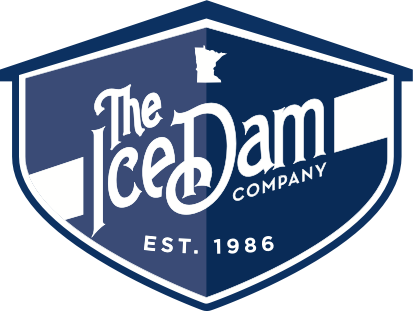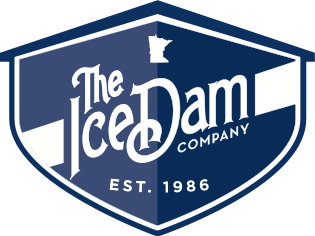Heat Tape
Heat tape, heat cable, roof de-icing cable & heat coils…
There are many terms that are used interchangeably to describe heat tape. Heating cables, heat tracing cables, heat tape, roof ice cables, self-regulating cables, roof and gutter de-icing cables are just a few. Often times these types of products are the first thing that homeowner’s turn to when they are trying to prevent ice dams. Speaking broadly, there are two avenues one can travel in their journey to address ongoing ice dam issues: 1) Architectural solutions and, 2) Non-architectural solutions. Architectural solutions refers to modifications made to the physical construction of the home or building, including insulation, ventilation, air leaks and exterior roofing systems. Non-architectural ice dams solutions are limited to two options including either roof shoveling or the installation of roof and gutter de-icing cables. The major advantage to architectural ice dam solutions is of course that the structure is being improved. The major disadvantage is cost. For those among us who can’t afford a $10,000 to $20,000 project, heat tape is a good option. Steve Kuhl, founder of The Ice Dam Company, wrote a three part series on heat cable for the Star Tribune that provides a balanced and informative look into the topic of heat cable and ice dam prevention that many find helpful. Here they are:
Not All Heat Cable Is Created Equal, Star Tribune, Minneapolis, Minnesota:
https://www.startribune.com/not-all-heat-cable-is-created-equal/565143082/
Should You Install Heat Cables To Prevent Ice Dams? Star Tribune, Minneapolis, Minnesota: https://www.startribune.com/should-you-install-heat-cables-to-prevent-ice-dams/564791562/
Heat Cable Installation, Star Tribune, Minneapolis, Minnesota: https://www.startribune.com/heat-cable-installation/565469132/
Click here to review the Nine most common locations for ice dams to form on Minneapolis homes.

Heat tape, when installed and functioning properly, can help to minimize the likelihood damage caused by ice dams. If you truly want to prevent ice dams in Minneapolis you need to go to the source. (Click here for more info on the causes of ice dams).
We encourage homeowners to take the necessary steps to properly deal with the sources that are contributing to ice dam formation before recommending heat cables. Whether it be the sealing of warm air leaks into your attic space, adding more insulation, or providing proper ventilation for your unconditioned spaces, there are certain things that can be done with your home to minimize the likelihood of ice dams and prevent damage to your home. Again, these tactics represent structural improvements and will cost many times more than a heat cable system.
Heat cables are a solid answer for situations where the property owner lacks sufficient resources for a remodeling project, or, when such efforts have been made but ice dam problems still exist.
Cost of heat tape in Minneapolis: $12 to $15 per foot of cable Installed
The cost of heat tape varies greatly from one project to the next depending on variables such as roof pitch and height, eave depth and length, cable type, gutter configuration and overall system design. A safe cost range for heat tape installation in Minneapolis is $30 to $60 per running foot of eave. This does not include the cost of having a licensed electrician modify the system which is occasionally necessary and can range from $250 to $500. We do not touch heat tape sold at big box stores such as Home Depot, Menards or Lowes because it is absolute junk. Sold under brand names including Easy Heat, Frost King and Wrap-On, these cables are not worth the money. We install self-regulating heat cable made by Radiant Solutions Company that carries a TEN YEAR warranty. We regularly tear out big box heat cables and replace them with quality cables because the cheap ones fail so quickly.
Why use The Ice Dam Company to install your heating cables?
Put quite simply, we are pros. When we’re not traveling the country removing ice dams, our crews stay busy installing roofs and gutters. We have installed more heat cable over the past 20 years than any contractor in Minnesota and are often hired by the most respected general contractors in Minnesota to install heat cable on their projects. Our sister company, Kuhl’s Contracting, was started in 1987 and is a highly respected exteriors company specializing in roofing, gutters and other exterior projects.
Below is some more information you should know prior to having heat tape installed on your house/building.
Seven Questions to Ask Your Heat Cable Installer
- Cable: What heat cable system are you installing? Avoid constant wattage brands including EasyHeat, FrostKing, Wrap-On or any cheap products bought online. Only install a long-lasting, self-regulating heat cable. Always ask for the technical documents relating to the heat cable being proposed.
- Warranty: How long is the manufacturers warranty on the cable you are installing? Constant wattage heat cable systems are warrantied for a maximum of only 1-2 years. Heat Tape Pro™ carries a 10 Year warranty. Ask for the warranty information in writing.
- Safety: Is your cable safe to install on my home? Constant wattage heat cables are not UL approved for installation on flat roofs, rubber roofs, wood, metal or any material other than sloped asphalt shingles. Ask your installer to see the cable manufacturers installation manual before work begins.
- Experience: What is your primary line of business? Are you a licensed contractor? How many heat cable systems have you installed? Are you experienced in all types of roofing, flashing and gutter systems? Can you provide proof of insurance?
- Maintenance: Do I have to remove leaves from around my heat cable? Constant wattage heat cables are not supposed to have prolonged contact with leaves or other combustibles. To avoid risk of fire, combustibles must be cleared away from the cable on a frequent basis. Read their manual.
- Repairable: Can my system be repaired if it is damaged? Constant wattage heat cables CAN NOT be repaired under any circumstance. The cable must be thrown away if even slight damage occurs (Squirrels!). Heat Tape Pro™ is a heavy-duty self-regulating heat cable that is simple and affordable to repair.
- Roof-Safe: Will the accessories used for my heat cable installation threaten my roof warranty? If you have an asphalt shingle roof, membrane roof, metal roof, synthetic roof or wood roof, make sure you understand the heat cable accessories being specified for your project because roof manufacturers warranties can be affected by the use of improper devices.
What type of heat tape does The Ice Dam Company use or recommend?
There are many manufacturers of heat tape out there. We install a 120v/240v, commercial grade, self-regulating ice dam prevention system from Radiant Solutions Company, called Heat Tape Pro™. It is the most innovative ice dam prevention system in North America and has won industry acclaim based on its quality and versatility.
Heat Tape Specifications
| Voltage | 120v or 240v |
|---|---|
| Watts | 5-6 watts per lineal foot at 50ºF |
| Heat Output (approximate) | 50-90°F |
| Heat Cable Warranty (Manufacturer’s) | 10 Years |
| Approximate Size of Heat Cable | 1/4″H x 1/2″W |
| Minimum Bend Radius | 1-1/8″ |
Quick Pros and Cons list for roof and gutter de-icing cable:
PROS:
- When an insulation/air sealing project isn’t practical, heat cable provides a reliable safeguard against damage caused by ice dams.
- When installed correctly, heat tape is very effective at creating melted pathways that allow water to escape your roof instead of backing up into the roof system and into your home.
- Heat Tape will keep your gutters and down spouts from backing up due to ice.
CONS:
- Do not increase energy efficiency of your home.
- They cost money to operate.
- Upfront materials and install cost (for good heat cables).
- Heat cables only work when properly monitored and/or plugged in.
Quick Fact or Fiction
Fact OR Fiction #1:
If I have heating cables, the eaves of my house will be completely clear of ice and snow.
Fiction
Heating cables do not clear the entire eave of snow and ice. They are usually installed in tracing patterns along the eaves and in the gutters and downspouts, called ‘zig-zags’. The purpose of heating cables is to provide and maintain a direct path to the ground for melted snow and ice on your roof. More than likely, you will still see some ice build up and some icicle formation.
Fact OR Fiction #2:
The heating cables that I can purchase at Home Depot, Lowes, or another big box stores are just as good as the commercial grade heating cables.
Fiction
There are many different types of heating cables that homeowners can purchase for their roofs. These different products also range widely in price. At Home Depot, you can purchase a 50′ heating cable for $49.99. That’s about $1 per foot uninstalled, approximately. If you purchase a self-regulating, commercial grade heating cable, installed from a local contractor, this can be close to $12-16 per foot for labor and materials. So which is better? Self-regulating cable, without question. Commercial grade cables (if installed correctly) have longer warranties and run more efficiently, can be overlapped during installation and are very durable.
Fact OR Fiction #3:
I will notice an increase in my electrical bill when my heating cables are left running all winter.
FACT
Depending on the kind of heating cables installed and the number of feet of heat cables installed, you will notice an increase in your energy consumption but that increase is higher for cheaper, constant wattage cables than from self-regulating cables.
Fact OR Fiction #4:
Heat cables prevent ice dams.
FICTION
Technically speaking, heating cables do not necessarily prevent ice dams. They melt small channels through snow and ice in an effort to provide a path for melted ice and water to run off of the roof.
Fact OR Fiction #5:
If I have completely air sealed all of the attic by passes, insulated properly, and provided sufficient ventilation to my attic space, I should not get ice dams.
MAYBE
This is partially true. If properly insulated, air sealed, and ventilated, the potential for ice dams is very low. However, there are still some situations, where ice dams will form regardless of the insulation, air sealing and ventilation. These types of ice dams are caused primarily by the individual homeowner use of the building, by the sun and other architectural considerations.
The Ice Dam Company has a strategic partnership with The Heat Cable Store, another source for quality self-regulating heat cable for managing ice dams and ice dam prevention. That company sells a few other brands of heat cable and deicing cable as well as a deeper selection of heat tape thermostats, sensors and control systems.





